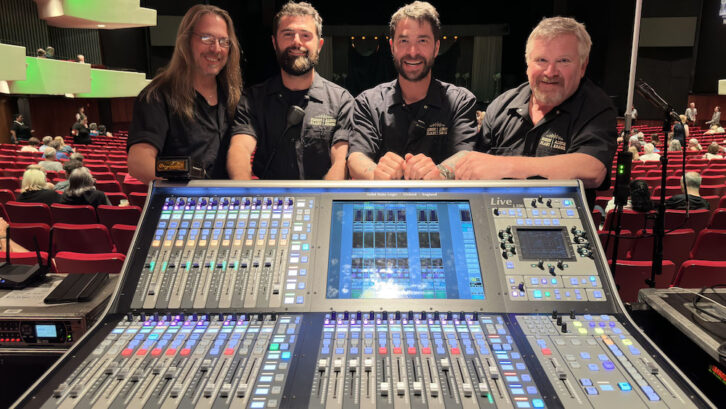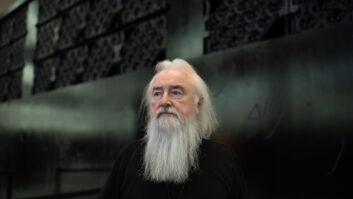
The conclusion of our Robert Plant/Alison Krauss ‘Raise The Roof’ tour coverage dives into the monitoring and miking of the production; don’t miss out on part 1!
If the P.A. speakers above the stage were different every day, the ones on it remained the same, as nearly all of the musicians heard themselves via floor monitors. At stageside, monitor engineer Chris “Coz” Costello mixed the proceedings on an Avid S6L-32D desk, creating mixes for wedges and Shure PSM1000 in-ear monitors, as Krauss opted for IEMs and multi-instrumentalist Duncan got a bit of both worlds, wearing a single earpiece. The tour carried a varied monitor setup based around d&b audiotechnik M2 stage monitors that were supplemented by L-Acoustics ARCS II sidefills and SB28 subs.
“It does get loud, but not like it’s Metallica,” joked Costello. “I was with Metallica for 10 years and that’s crushing loud—but this does get a healthy amount of volume. Robert likes guitars in his face and a really good chunk of vocal with lots of top end on it. However, Alison likes to hear a pin drop. She has a very quiet stage when she’s with Union Station, where pretty much everything’s on direct boxes and there’s no loud amps on stage, so this is a very delicate balance. It’s not fragile, though—it works and they’re both comfortable with it.”
Keeping that balance may have been a challenge, but it was one that played into Costello’s background as a monitor engineer: “It’s interesting to mix because I wear one earbud where I’m listening to Alison’s mix the entire time—and then I’ve got cue wedges behind me so I can hear Robert’s mix the whole show. It took a while to get used to it, but I could do it because I’m also the monitor engineer on Saturday Night Live. With SNL, I have to listen to and separate so many incoming sources of information, whether it’s processing audio, an A.D. doing countdowns in and out of commercials, the intercom for the audio folks—there’s all kinds of things. I’m used to separating a lot of different sources and on this tour, their mixes are quite different. Alison listens very quietly to the other instruments on stage, and primarily her vocal—and her fiddle into her vocal! She plays fiddle into the vocal mic; she doesn’t use a DI. She knows how to get the exact tone out of it that she wants to hear—and what she wants to hear is pretty much what [FOH engineer] Mark Kennedy wants to hear out front, so all these things come together very well.”
Krauss’s vocal mic in question was a Shure KSM8, while Plant used a standard SM58, much as he has throughout his entire career. All vocals went directly into Rupert Neve Designs Shelford Channel preamps shared by both mix positions, using gain settings that worked for both engineers. “We take the outputs of that and run it into our desks separately,” said Costello. “The Shelford makes all the difference in the world. Mark has been using them for a long time and they’re working great for me, too; they add all kinds of top end, and that is always the primary thing that Robert is looking for—more level and more top end.”

While capturing Krauss’ violin with the vocal mic might be unusual, there were other alternative miking methods in play elsewhere on the stage, as Kennedy explained: “Jay Bellerose has a very unorthodox drumming style; he’s like a percussionist nearly, as well as a drummer. He has a 1940s ‘Bomber Kit’ that sounds absolutely amazing, but it’s quite a complicated setup. It was made in America without steel rims because all the metal was being used for the war effort, and there’s also two wooden skull blocks that were made in 1920. I use a Shure VP88 very unusually as a stereo overhead ‘picture mic’ to get all the shakers and different things he’s hitting. Normally people use it as a reporter mic, but myself and our drum tech were just listening to the playback, and with the VP88 open, Sennheiser 421s on the toms and little bit of kick drum, I’d say it’s a perfect drum kit. It’s just amazing how well it works.”
Guitarist JD McPherson had to create a broad variety of tones, depending on his role in a given song, so miking his vintage Fender guitar amps was done with an eye towards enabling as much variety as possible. While the amps were single-speaker models, they were each double-miked and blended after the fact, with the Vibrolux getting a pair of Shure 57s while the Tweed was captured with a pair of SM7Bs. Other guitar amps were nabbed with an Audio-Technica AT4050 and a 57 to get the classic mix of a dynamic and a large-diaphragm condenser together, and elsewhere on stage, a Yamaha rotary speaker Leslie-style guitar amplifier was surrounded by no less than three Shure 58s to capture its wobbling sound.
Helping keep tabs on the stage was Artie Aymong. “As the monitor tech and deck guy, Artie plugged up the stage and the artists absolutely loved him,” said Costello, “but I think one of the most important aspects was the bond we have from Saturday Night Live. He was my deck guy on SNL for years until he took over the head audio position on the floor at The Tonight Show with Jimmy Fallon. We have telepathy in a way because of SNL, so on this tour, I would watch the whole band, but if I was looking one way, he was looking the other way; if there was a cue or somebody needed something, he’d call it in and I was, ‘Yeah, saw it, got it.’ Everything was smooth, and he was so important for making that happen.”
The end result of all the crew and performers’ efforts was an evening of music that checked off all the boxes for the audience, serving up a variety of tracks from the duo’s albums and more. “It does go off on fantastic musical tangents from the basis of the records, but fundamentally, it is faithful to the two albums,” said Kennedy. “Also, we’re doing some stuff like ‘When the Levee Breaks’ and ‘Rock And Roll’ from Led Zeppelin—which are entirely different to the way Led Zeppelin ever played them! Alison and Robert have such complimentary voices that work so well together, it makes for a great show. Every night, they’re just blinding, you know?”







